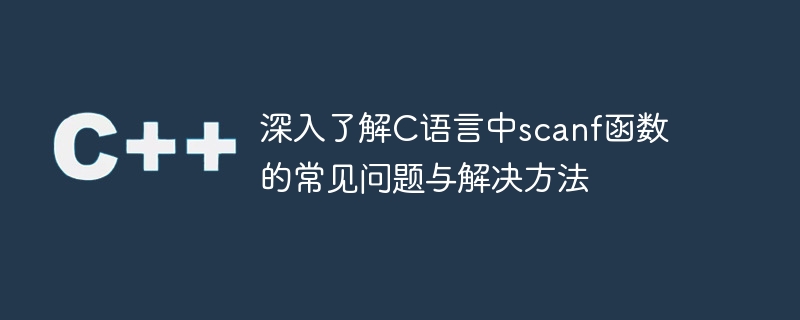

In-depth understanding of common problems and solutions of the scanf function in C language
Introduction:
In C language, the input function scanf is one of the most commonly used functions First, it is used to receive user input from the standard input stream. However, due to the complex characteristics and usage of the scanf function, some problems are often encountered. This article will introduce in detail the common problems of the scanf function, and give solutions and specific code examples.
1. The return value of the scanf function
When using the scanf function, we need to pay attention to its return value. The scanf function returns the number of items successfully read and converted. If the return value is less than the number of parameters, it means that there are input values that were not successfully read. This return value is often used to determine whether the user's input is legal. The following is a sample code:
#include <stdio.h>
int main() {
int num1, num2, result;
printf("请输入两个整数:");
if (scanf("%d %d", &num1, &num2) != 2) {
printf("输入错误,请输入两个整数。
");
return 1;
}
result = num1 + num2;
printf("两个整数的和为:%d
", result);
return 0;
}In the above code, the scanf function is used to receive two integers input by the user. If the input value does not meet the requirements (i.e. two integers), an error message will be printed. and returns an error code.
2. Input buffering problem of scanf function
The scanf function will put the data entered by the user into the input buffer when inputting, and then convert it according to the rules of the format string. However, due to the characteristics of the input buffer, problems such as infinite loops or incomplete reads can easily occur. The following is sample code for some common input buffering problems and solutions:
#include <stdio.h>
int main() {
int num;
char ch;
printf("请输入一个整数:");
scanf("%d", &num);
// 清空输入缓冲区
while ((ch = getchar()) != '
' && ch != EOF);
printf("输入的整数是:%d
", num);
return 0;
}In the above code, if the user enters an integer Later, extra characters (such as letters) are input. By clearing the input buffer in a loop, you can avoid the extra characters from interfering with subsequent input.
#include <stdio.h>
int main() {
char name[20];
printf("请输入您的姓名:");
fgets(name, sizeof(name), stdin);
printf("您的姓名是:%s
", name);
return 0;
}In the above code, fgets function is used instead of scanf function, which can avoid incomplete reading when inputting strings. The problem.
3. Issues with the format string of the scanf function
The format string of the scanf function is used to indicate the format and type of input. During use, you need to pay attention to the correctness and rationality of the format string. The following is sample code for some common format string problems and solutions:
#include <stdio.h>
int main() {
char ch;
printf("请输入一个字符:");
scanf(" %c", &ch); // 注意前面的空格
printf("输入的字符是:%c
", ch);
return 0;
}In the above code, due to the preceding format string Added a space to ignore user-entered special characters such as spaces and tabs.
#include <stdio.h>
int main() {
char str[10];
printf("请输入一个字符串(最多10个字符):");
scanf("%9s", str);
printf("输入的字符串是:%s
", str);
return 0;
}In the above code, user input is avoided by limiting the string length to a maximum of 9 characters in the format string The target array size is exceeded.
Summary:
This article provides an in-depth understanding of common problems with the scanf function in C language, and provides solutions and specific code examples. By rationally using return values, solving input buffering issues, and controlling format strings, we can make better use of the scanf function and avoid some common mistakes. I hope this article can help readers understand and use the scanf function.
The above is the detailed content of Solve common scanf function problems and their solutions. For more information, please follow other related articles on the PHP Chinese website!
 what does oem mean
what does oem mean
 oracle add trigger method
oracle add trigger method
 How to repair win7 system if it is damaged and cannot be booted
How to repair win7 system if it is damaged and cannot be booted
 The role of server network card
The role of server network card
 Word table spread across pages
Word table spread across pages
 String array assignment method
String array assignment method
 Introduction to the main work content of the backend
Introduction to the main work content of the backend
 What does ts version mean?
What does ts version mean?
 The difference between win10 home version and professional version
The difference between win10 home version and professional version




